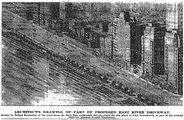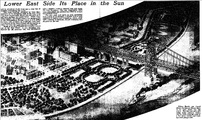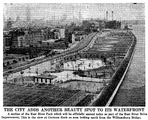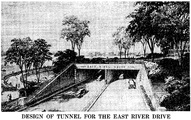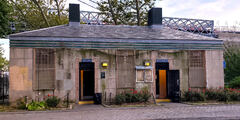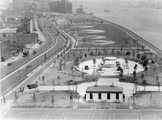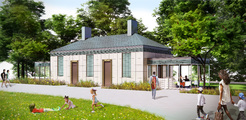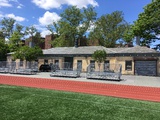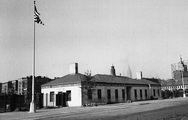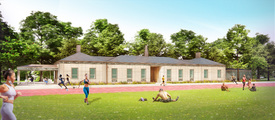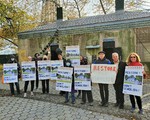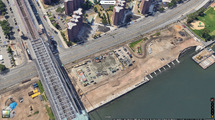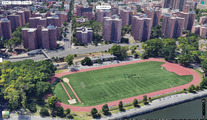East River Park
Frank da Cruz[ New Deal Park Structures Face Demolition in NYC ] [ Lower East Side Preservation Initiative ] [ Petition to save historic buildings ]
Bronx NY
16 August 2020
Most recent update: Sun Jul 16 13:54:16 2023
The park contains at least ten New Deal buildings, but as far as I know the park itself has never been classified as a New Deal project. A little digging reveals that this is because it was part of the East River Drive project, which was a New Deal project. Taken together, the references below bear this out; the highway and the park were built together with funding and labor from the CWA, PWA, and WPA. The project is the mirror image of the West Side Improvement, which comprised the Henry Hudson Parkway and the adjoining Riverside Park (as well as a boat basin and a bridge).
Robert Caro says[1] that the Triborough Bridge connected to Manhattan at 125th Street on the East River but there was no highway anywhere near that spot, so Moses decided to build one: a highway along the river and a park to go with it. Covenants dating back to the 1830s when the City owned the land along the river gave it the right to reclaim a 60-foot strip along the waterfront if it ever wanted to build a street there. In order to build a six-lane highway and a park, Moses reclaimed the sixty-foot strip and added a ten-foot platform over the river (and also, as indicated elsewhere[5], extended it further with landfill). Then Moses "made another trip to Washington and asked the PWA to contribute an additional $6,000,000 to acquire land for the Drive so that the bridge would be made more accessible to motorists and more of them would be perusaded to pay tolls to use it. The PWA wouldn't give $6,000,000 — but it would give $2,000,000. Moses took La Guardia on a tour of the proposed improvement. La Guardia, who lived in an apartment at 106th Street and Fifth Avenue, was keenly aware of the park needs of the neighborhood. And he was fascinated by the engineering aspects of the work. Moses persuaded him that men paid by CWA and its successor agencies could be reassigned from other city departments to provide the labor needed for the job."[1]
Many sources note that the East River Park was a joint project of the NYC Parks the Department and the office of Manhattan Borough President Stanley Isaacs, with the implication that the borough's contribution was out of City funds, but Reference 9 below shows that Isaacs applied for and received his own PWA funding for it.
The park will be reconstructed as part of the NY City / federal government East Side Coastal Resiliency plan for 2020-2026: "Under the currently embattled E.S.C.R. project, the entire 60-acre East River Park would be deforested, with all of its nearly 1,000 mature trees cut down, and most of its structures demolished. The park would then be raised 8 feet to 10 feet, putting it above the floodplain to protect the bordering community from a repeat of the coastal flooding seen in Hurricane Sandy in 2012. Meanwhile, the plan's opponents back an earlier resiliency scheme that would not destroy the existing park."[16] Deborah Wye of LESPI reports, "we had an enthusiastic crowd at our rally [on Sunday November 14th] and a lot of speakers from allied organizations, as well as the newly elected Council person from the District: Chris Marte. Right now there are some legal issues that have stopped construction temporarily. No one knows what will happen."
- Caro, Robert, The Power Broker, Vintage Books (1975), pp.393-394.
- East Side Highway Believed Assured - Mayor Receives Word that PWA Favors Granting $20,000,000 to Start Work, New York Times, 27 January, 1935, pp.67-68: "Construction in the near future of the long-projected East River Drive was predicted yesterday by Borough President Samuel Levy of Manhattan. His statement followed the receipt from Washington by Mayor La Guardia of assurances that the $20,000,000 to $25,000,000 needed for the project probably would be granted soon by the Federal Public Works Administration. ... The drive, when completed, will have, when on the surface, two 32-foot roadways separated by a mall. On its river side will be a promenade protected from the river by a parapet. Shrubs will be planted along its entire length with the aim of making it a new and better Riverside Drive."
- East River Drive Open, New York Times, 31 October 1936, p.18: "The multiple character of the project shows once more how fortunate the city is in having a man like Mr. Robert Moses serving it in his several capacities ... As Park Commissioner he seized the opportunity to reclaim a waterfront, hitherto drab in the extreme, by landscaping the new drive and providing the recreational facilities."
- Roosevelt 'Built' East Drive Link, New York Times, 30 June 1937, p.12: "President Roosevelt, because of his personal interest in the development of the waterfront of New York City, made available the WPA funds for the Grand to Twelfth Street section of the East River Drive, which was formally opened yesterday [at an event attended by more that 10,000 people including] Mayor La Guardia, Park Commissioner Rober Moses, Borough President Samual Levy, Lieut. Col. Brehon B. Somervell, WPA Administrator... [the Borough President cited] the transformation of the area that would bring modern buildings with more light, air and sunshine together with parks and playgrounds..."
- New 50-Acre Riverfront Park to Give Lower East Side Its Place in the Sun, New York Times, 3 July 1938, pp.92-95: "Fifty acres of new play space will be presented to the children of Manhattan's lower East Side with the completion of the new park now under construction between the East River Driver and the river front. ... Created through the cooperation of Park Commissioner Robert Moses and Borough President Stanly M. Isaacs, whose jurisdictions overlapped in this unique undertaking, the park and contiguous sections of the East River Drive will cost approximatley $12,500,000..." A photo caption says "North of the Williamsburg Bridge a completed section of the East River Drive flanks the new-made land, where the fill is almost complete and WPA workers are now grading."
- WPA Begins on East River Drive, New York Daily News, 18 January 1939, p.24. "...ground was broken yesterday for another WPA project – a new sector of the East River Drive. It will cost $10,700,000, of which $4,000,000 is a PWA Grant." This confirms that the WPA was supplying the labor while the PWA supplied the cash for materials and other expenses.
- NYC Department of Parks Press Release, 26 July 1939: "As part of the general scheme of the East River Drive Improvement which is a vital section of New York's Belt Parkway system, the Manhattan Borough President's office and the Park Department have jointly worked out plans for this new waterfront park similar to the West Side development with the work being performed under the direction of the Borough President's office." Characteristically, this long press release does not mention New Deal assistance at all.
- East River Park Will Open Today, New York Times, 27 July, 1939, p.16 (photo).
- New Plans Lift Cost of East River Drive, New York Times, 25 November 1939, p.10: "New work in connection with East River Drive will add $2,291,485 to the cost of the high-speed highway, according to plans filed with the Public Works Administration by Manhattan Borough President Stanley M. Isaacs. The plans, which would bring to total cost of the project $12,956,485, have been approved by the regional office of the PWA..."
- Design of Tunnel for the East River Drive, New York Times, 8 January 1940, p.2 (photo).
- New Link Is Opened in East River Drive, New York Times, 19 June 1940, p.25. Manhattan Borough President Isaacs made special mention of "rambling along this new stretch of pedestrian highway". "Mayor La Guardia praised the Roosevelt Administration for 'devising the American way' of providing for those in need by giving them employment'" and that "the Drive would not have been possible without Federal aid and expressed gratitude to the Public Works Administration and President Roosevelt for their aid. ... The East River project, Mayor La Guardia said, was an example of 'what it means to have efficient men run a city government, instead of politicians.' ... The 'Dead End' dock, as the theatre and motion pictures saw the old Fifty-third Street wharf, is gone and parks and playgrounds on the structure have been designed to eliminate the social conditions pictured in the play. Typical of the efforts to use every available inch of space for park or recreation areas are the small parks atop the drive at Fifty-sixth Street, Fifty-seventh street and Fifty-eighth Street. The link to be opened to traffic this morning cost $10,7000,000, of which 45 per cent, or $4,794,750, was contributed by the the United States Government through the Public Works Administration."
- Francis Cormier, "Some New York City Parks and Parkways", in Landscape Architecture Magazine, April 1939, pp. 124-136; includes a focus on East River Park and confirms Gilmore D. Clarke for the landscape and Aymar Embury II for the architecture and notes that in all the projects covered in the article "The lion's share of the work has been done by WPA forces" (thanks to Deborah Wye for this reference).
- Moses, Robert, Public Works, McGraw Hill (1970), p.32: Moses says "East River Park in Manhattan was created by landfill extension" but neglects to mention the WPA laborers who did the work[5].
- Hilary Ballon and Kenneth T. Jackson, Robert Moses and the Modern City, W.W. Norton & Company (2007), pp.187-189.
- Barbara Wye, Threatened East River Park Buildings Recognized for Architectural Distinction, Bowery Boogie website (accessed 4 December 2020): "Two East River Park Art Deco gems were recently deemed eligible for the State and National Registers of Historic Places by the New York State Historic Preservation Office (SHPO). Both the Track House near East 6th Street and the Tennis Center Comfort Station between Rivington and Delancey Streets were recognized for their historical significance. Based on research and an application submitted this past winter by the Lower East Side Preservation Initiative (LESPI), the determination means that the SHPO must review any plans to alter the buildings, including current intentions to demolish them under the East Side Coastal Resiliency project."
- Lincoln Anderson, Save historic East River Park buildings, preservationists cry, The Village Sun, 18 November 2021.
- Preserving the East River Park's Historic Structures, letter from Richard D. Moses, President, LESPI, to Signe Nielsen, President Public Design Commission of the City of New York, September 15, 2019, advocating preservation of the East River Park's New Deal buildings.
- East Side Coastal Resiliency, nyc.gov, accessed 22 November 2021.
| Created by C-Kermit Photogallery 3.15 July 16, 2023 |
